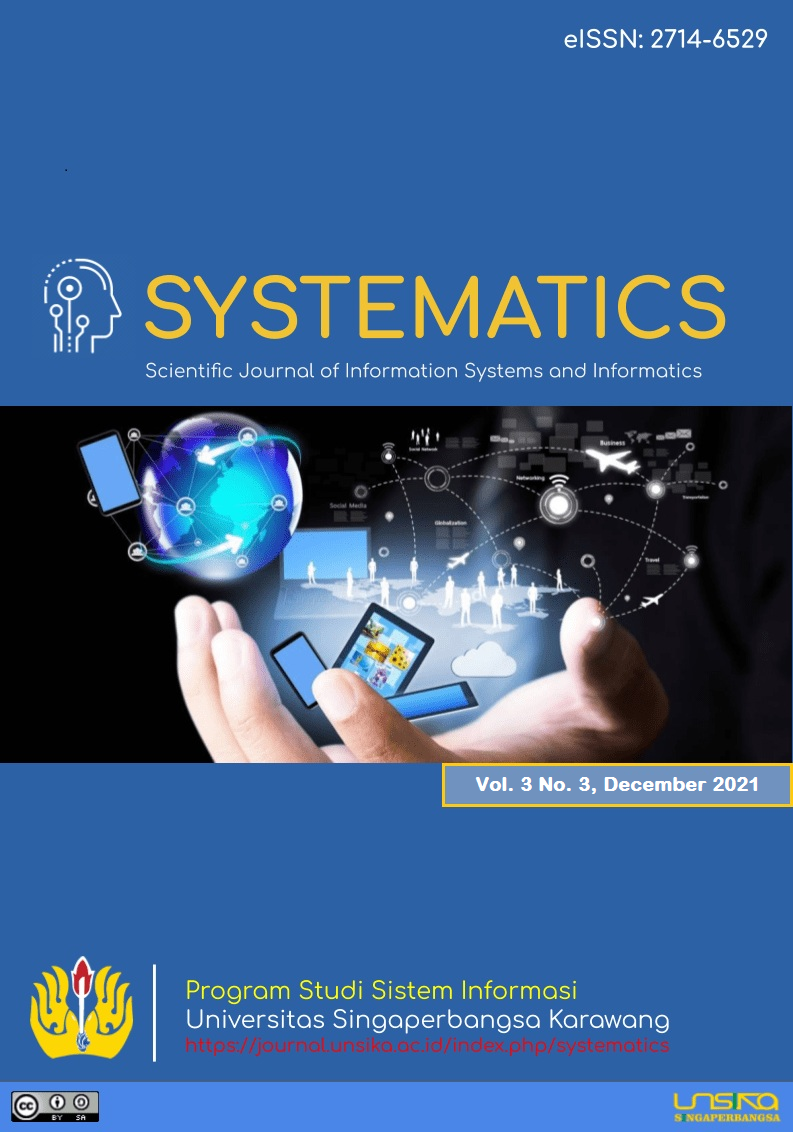Design of Broiler Supply Chain Traceability System through Blockchain-based Android Application
Perancangan Sistem Ketertelusuran Rantai Pasokan Ayam Broiler melalui Aplikasi Android berbasis Blockchain
DOI:
https://doi.org/10.35706/sys.v3i3.5955Abstract
The majority of supply chain management system that are currently implemented are still centralized
system. The system has weaknesses such as still having a centralized authority so that it can cause
system security problems, the data is not presented in real time, not transparent and it takes time in
processing and presenting data. One of the new alternatives that can now be used to overcome this
problem is to utilize blockchain technology. Blockchain is a decentralized and distributed ledger that
keeps a record of transactions in a block. Each block in the blockchain contains data from all
transactions in the system over a certain period of time and can create a digital signature that can be
used to verify the validity of information related to the next and previous blocks. This research aimed
to design a broiler supply chain traceability system through blockchain-based android application
using prototyping method. The result of this research is that blockchain-based android application can
record transactions and information of actors, namely: breeders, companies, collectors, retailers and
consumers and can trace broiler transactions and information in real time and transparently using
BatchID originating from the actors so as to generate Users’ trust.
Downloads
References
[BPS] Badan Pusat Statistika, “Distribusi perdagangan komoditas daging ayam ras Indonesia,”
ISBN: 978-979-064-893-7, katalog BPS: 8201020, 2015.
S. Bogart, R. Kerry, “The Blockchain Report: Welcome to the Internet of Value,” New York
(US): Needham & Company LLC, 2015.
J. D. Bruce, “Purely P2P crypto-currency with finite mini-blockchain,” 2013.
A. Litke, D Anagnostopoulos, T. Varvarigou, “Blockchain for supply chain management.
Architectural elements and challenges toward a global scale deployment,” Vol 3 (1), Logistics,
S. Olnes S, J. Ubacht, M. Janssen, “Blockchain in government: Benefits and implications of
distributed ledger technology for information sharing,” Vol 34 (3), Government Information
Quarterly, 2017, pp. 335–364.
S Saberi, M. Kouhizadeh, J. Sarkis, L Shen,”Blockchain technology and its relationships to
sustainable supply chain management,” Vol 57 (7), International Journal of
Production Research, 2019, pp. 2117-2135.
M. Scherer, “Performance and scalability of blockchain networks and smart contracts
[disertasi],” Umeå: Umeå University, 2017.
E. Androulaki, A. Barge, V. Bortnikov, C. Cachin, K. Christidis, A. De Caro, D. Enyeart, C
Ferris, G. Laventman, Y. Manevich, et al, “Hyperledger Fabric: A Distributed Operating
System for Permissioned Blockchains,” Proceedings of the thirteenth EuroSys conference,
Porto, Portugal. USA: ACM, 2018, pp. 1–15
Hyperledger 2020. https://hyperledger-fabric.readthedocs.io/en/release2.2/key_concepts.html
di akses tanggal 20 Januari 2021.
Raharjo, Budi, “Pemograman Android Dengan FLUTTER,” Bandung: INFORMATIKA,
R. S. Pressman, B. R. Maxim, “Software Engineering: A Practitioner’s Approach,” Ed ke-8.
New York (US): McGraw-Hill, 2015.
Satzinger, Jackson, dan Burd, “Systems Analysis and Design in a Changing World,” 2015.
M. Masse, “REST API Design RuleBook”, O'Reilly Media, Gravenstein Highway North
Sebastopol, 2012.
Downloads
Published
How to Cite
Issue
Section
License
Copyright (c) 2021 SYSTEMATICS

This work is licensed under a Creative Commons Attribution-ShareAlike 4.0 International License.
Authors who publish with this journal agree to the following terms:
- Authors retain copyright and grant the journal right of first publication with the work simultaneously licensed under a Creative Commons Attribution-ShareAlike 4.0 International License. that allows others to share the work with an acknowledgement of the work's authorship and initial publication in this journal.
- Authors are able to enter into separate, additional contractual arrangements for the non-exclusive distribution of the journal's published version of the work (e.g., post it to an institutional repository or publish it in a book), with an acknowledgement of its initial publication in this journal.
- Authors are permitted and encouraged to post their work online (e.g., in institutional repositories or on their website) prior to and during the submission process, as it can lead to productive exchanges, as well as earlier and greater citation of published work (See The Effect of Open Access).







